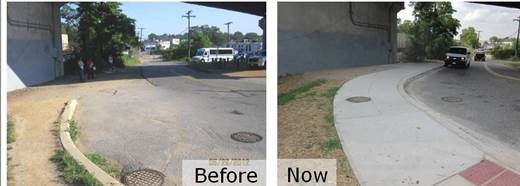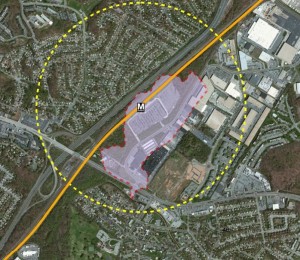Metro Studying Ways to Improve Bike/Ped Access to Stations
Improving walk and bike access is a cost effective way to increase ridership and improve the efficiency of the Metrorail network. Where are these improvements needed and how should we (as a region) prioritize them?
In a number of earlier posts starting last summer, we’ve discussed the concept of walk sheds and explored the relationship between walkability, land use, and Metrorail ridership. One conclusion of this effort: grow the size of the walk shed and you’ll grow ridership.
Generally, we only have control over what happens on our own property. While we have made great strides in identifying and prioritizing bike/ped access improvements on our own property, increasing the size of the walk sheds requires coordination with state or local agencies who own, plan, design and construct roads, sidewalks and pathways near our stations. We know that in order to have a larger impact on walk and bike access, we need to cast a wider net and identify projects that are up to one mile from our station entrance. We have created a plan — the Station Access Investment Strategy — to highlight some of these projects as priorities for our local partners to use as they develop their capital improvement plans.
Our Station Access Investment Strategy project builds off MWCOG’s recent Transportation System and Community Preservation study of commuter and Metrorail stations. The COG study reviewed dozens of existing planning studies and pulled out and collected recommendations for new or improved sidewalks, crosswalks, shared-use paths, bike parking, bike lanes, wayfinding signage and other access improvements. Since the COG study focused only on 24 Metrorail stations, our project is batting clean-up by evaluating the remaining 67 stations in the system.
We are wrapping up our project lists for each station this month. We’ve seen that there are 1,000s of potential projects — including curb ramps, crosswalks, lighting, hiker-biker trails, bike lanes and other elements — that could improve and/or expand the bike/ped network serving our stations. Given the large number of potential projects, we are developing a method for grouping them together in a way that supports constructability. In addition, we are developing criteria to prioritize these projects. Some criteria we are looking at include:
- Safety, i.e., does a project improve access in an area where we’ve seen a high rate of ped/cyclist crashes?
- Expansion the walkshed (and increase ridership and revenue)
- Population density
- Ability to bridge the gap to libraries, schools and social service providers
Once we’ve fleshed these criteria out a bit, we’ll post them so we can get your feedback.

Sidewalk Connection at Brookland-CUA
Our goal is to refine and prioritize the project lists this fall, as well as outline foreseeable funding streams, then discuss them with our jurisdictional partners this winter. We’ll then hand the lists over to them to they can begin to integrate them into their project development processes. Many of these projects have the potential to more than offset their capital investment via increased rail ridership, which leads to farebox revenue and lower operating subsidies for Metrorail. Not to mention the reduced cost of roadway maintenance when auto trips are diverted onto the rail network.
We’ll keep you posted as we advance this important body of work.



Recent Comments